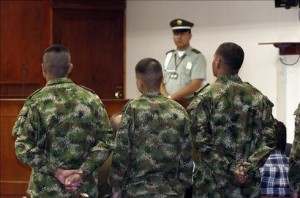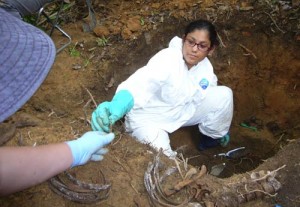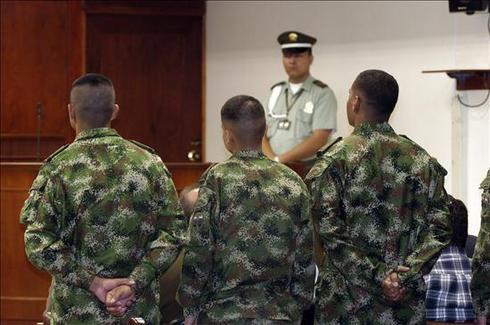Extrajudicial Killings in Colombia Demand Action
On June 12, the Nasa tribe, an indigenous community from the southwestern highlands of Colombia, released a video of members of the Colombian army standing around the naked corpse of 30-year-old Luis Alberto Cunda. The Army insisted that Cunda belonged to the Revolutionary Armed Forces of Colombia (FARC) and had engaged in a firefight before they shot him dead. The Nasa tribe, however, disputed the army’s version of events, maintaining that Cunda was falsely accused of being a FARC guerilla, was forced from his home, beaten and finally murdered. According to human rights leader Francisco Isaias Cifuentes, as well as the Nasa community, Cunda’s body bore signs of physical abuse. [1] Both the United Nations and the International Criminal Court (ICC) reported this was by no means an isolated incident but rather just one of thousands of extrajudicial killings carried out by the Colombian military since the early 2000s.

Extrajudicial killings have become an increasingly troubling subject in Colombia since the first charges were filed against Colombian military officers in 2008. According to Alberto Yepes, a human rights investigator in Bogota, the killings have occurred in 32 of 33 Colombian provinces. [2] In the southeastern region of Meta, a graveyard called La Macarena, “allegedly contains the bodies of over 2,000 people, including suspected victims of extrajudicial murders,” according to a report by the U.N. Human Rights Council. [3] NGO and IGO reports also estimate that at least 2,000 people were victims of such killings from 2002-2008, with others claiming the number might be even greater than 3,000. [4] Amnesty International reports that the killings are ongoing, with 17 such cases occurring in the first six months of 2011. [5]
In light of Colombia’s half-century dichotomous conflict involving the left-wing guerillas and right-wing militias, these extrajudicial killings, perhaps unsurprisingly, have often been attributed to the so-called “false positives” phenomenon, whereby military forces execute innocent civilians and report them as enemy combatants killed in combat as a way to boost kill counts. [6] According to Ivan Cepeda, a congressman who once headed a state victims group, extrajudicial killings are committed for two reasons: first, inflated body counts lead to promotions, vacations, and other benefits for military personnel; and second, high numbers reinforce the perception that the government is succeeding in the fight against terrorists. [7]
Amnesty International reports that the victims of these crimes are usually “members of indigenous communities, people of Afro-descent, peasants and community activists such as human rights defenders and trade unionists.” [8] The National Indigenous Organization of Colombia pointed out that between January and November 2011, 111 indigenous community members died from violent causes, many of the deaths apparently from extrajudicial killings. [9] Human rights groups claim that because these victims are usually among the poor, unemployed or mentally challenged, they are the least likely to seek and receive justice for the iniquities committed against them. [10]

Human rights organizations and other IGOs acknowledge that Colombian authorities have taken some steps to right these egregious wrongs. For example, the Colombian government has approved the Victims and Land Restitution Law, which provides that stolen property must be returned to the rightful owners. Colombian authorities have also prosecuted a greater number of military personnel since 2008, with a few particularly noteworthy convictions. For example, in July 2011, eight Colombian soldiers were sentenced to 28 and 55 year prison terms for killing two young men in the province of Santander in 2008. [11] Also, in early 2012, six army officers and soldiers were charged with the 2008 murder of mentally challenged day laborer Leonard Porras and sentenced to prison for a minimum of 35 years. [12]
However, human rights organizations adamantly maintain that the Colombian government has not done nearly enough to correct the abuses and that its inaction has fueled infringements on land rights. According to Amnesty International, “those working toward land restitution remained largely unprotected and vulnerable to extrajudicial killings, ‘undermining the implementation of the law.’” [13] Other human rights organizations claim that even though the Victims and Land Restitution Law passed and is presumably being enforced, the process of actually returning the stolen land has been ineffectual. The reported 17 extrajudicial killings that took place in the first six months of 2011 represent an increase over the same period in 2010. A large part of the problem is that many of these cases have still gone before the military justice system, which usually closes investigations without hearing the case properly. [14] In addition, the United Nations reported, “there were inconsistencies about what happened in the accounts of military authorities and a tendency by some officials to discredit and stigmatize victims and obstruct justice.” [15] Even though many of these cases have been brought before civilian courts, out of about 3,000 estimated cases, only about 170 of them have received proper verdicts. [16] In a troubling move, President Juan Manuel Santos recently supported legislation that would divert current civilian cases to military jurisdiction. Particularly troubling for many human rights organizations, the government has passed the “Framework for Peace” legislation, which could “allow human rights abusers, including members of the security forces, to benefit from de facto amnesties.” [17] Human Rights Watch director for the Americas, Jose Miguel Vivanco, has said, “What’s most serious about the text is that it offers those most responsible for crimes against humanity the benefit of not serving a single day in prison.” However, the government asserts that the amnesty will not cover crimes committed by armed forces outside the conflict, such extrajudicial executions, espionage or corruption. [18]

Given their record, it is reasonable to be suspicious of military courts, which are almost certainly more concerned with protecting the military’s prestige rather than ensuring justice to the victims. In order for justice to be truly delivered, the Colombian government should maintain civil jurisdiction over the cases. In addition, the government should enforce the Victims and Land Restitution Law more stringently to ensure that victims are able to reclaim their stolen property. In the past, the government’s lackadaisical approach to enforcing the law has meant that many seeking to reclaim lost property are often defenseless against abuses. It should be noted that human rights organizations have questioned whether Colombian domestic courts are sufficient. Indeed, it has been pointed out that even in many Colombian civilian courts impunity remains high, and in the past many trials were “exacerbated by threats against, and killings of witnesses, lawyers, prosecutors, and judges”. [19]
Recently, the ICC has agreed to look into the matter. In addition, the U.N. Human Rights Council, in a recently issued report, has demanded that Colombian authorities exhume these victims to determine their identities. [20] These options should be pursued in the search for true justice in Colombia.
Please accept this article as a free contribution from COHA, but if re-posting, please afford authorial and institutional attribution.
Exclusive rights can be negotiated.
[1] Pettersson, Olle. “Colombian Army Commits ‘Extrajudicial Execution’: Indigenous Community”. Colombia Reports, 12 June 2012. Accessed 20 June 2012. http://colombiareports.com/colombia-news/news/24528-indigenous-community-denounces-extrajudicial-execution.html
[2] Kraul, Chris. “In Colombia, 6 Sentenced in ‘False Positives’ Death Scheme”. Los Angeles Times, 14 June 2012. Accessed 21 June 2012. http://articles.latimes.com/2012/jun/14/world/la-fg-colombia-false-positives-20120614
[3] Pettersson, Olle. “Colombian Army Commits ‘Extrajudicial Execution’: Indigenous Community”. Colombia Reports, 12 June 2012. Accessed 20 June 2012. http://colombiareports.com/colombia-news/news/24528-indigenous-community-denounces-extrajudicial-execution.html
[4] Barrett, Brandon. “Colombia Should Exhume Victims of Military Killings: UN”. Colombia Reports, 19 June 2012. Accessed 21 June 2012. http://colombiareports.com/colombia-news/news/24651-colombia-should-exhume-bodies-of-extrajudicial-victims-un.html
[5] Leonard, Christan. “Colombian Human Rights Show Little Improvement: Amnesty International”. Colombia Reports, 24 May 2012. Accessed 21 June 2012. http://colombiareports.com/colombia-news/news/24233-colombian-human-rights-show-little-improvement-amnesty.html
[6] Barrett, Brandon. “Colombia Should Exhume Victims of Military Killings: UN”. Colombia Reports, 19 June 2012. Accessed 21 June 2012. http://colombiareports.com/colombia-news/news/24651-colombia-should-exhume-bodies-of-extrajudicial-victims-un.html
[7] Kraul, Chris. “In Colombia, 6 Sentenced in ‘False Positives’ Death Scheme”. Los Angeles Times, 14 June 2012. Accessed 21 June 2012. http://articles.latimes.com/2012/jun/14/world/la-fg-colombia-false-positives-20120614
[8] Leonard, Christan. “Colombian Human Rights Show Little Improvement: Amnesty International”. Colombia Reports, 24 May 2012. Accessed 21 June 2012. http://colombiareports.com/colombia-news/news/24233-colombian-human-rights-show-little-improvement-amnesty.html
[9] Ibid.
[10] Kraul, Chris. “In Colombia, 6 Sentenced in ‘False Positives’ Death Scheme”. Los Angeles Times, 14 June 2012. Accessed 21 June 2012. http://articles.latimes.com/2012/jun/14/world/la-fg-colombia-false-positives-20120614
[11] Leonard, Christan. “Colombian Human Rights Show Little Improvement: Amnesty International”. Colombia Reports, 24 May 2012. Accessed 21 June 2012. http://colombiareports.com/colombia-news/news/24233-colombian-human-rights-show-little-improvement-amnesty.html
[12] Kraul, Chris. “In Colombia, 6 Sentenced in ‘False Positives’ Death Scheme”. Los Angeles Times, 14 June 2012. Accessed 21 June 2012.
http://articles.latimes.com/2012/jun/14/world/la-fg-colombia-false-positives-20120614
[13] Leonard, Christan. “Colombian Human Rights Show Little Improvement: Amnesty International”. Colombia Reports, 24 May 2012. Accessed 21 June 2012. http://colombiareports.com/colombia-news/news/24233-colombian-human-rights-show-little-improvement-amnesty.html
[14] Ibid.
[15] Barrett, Brandon. “Colombia Should Exhume Victims of Military Killings: UN”. Colombia Reports, 19 June 2012. Accessed 21 June 2012. http://colombiareports.com/colombia-news/news/24651-colombia-should-exhume-bodies-of-extrajudicial-victims-un.html
[16] Kraul, Chris. “In Colombia, 6 Sentenced in ‘False Positives’ Death Scheme”. Los Angeles Times, 14 June 2012. Accessed 21 June 2012. http://articles.latimes.com/2012/jun/14/world/la-fg-colombia-false-positives-20120614
[17] Leonard, Christan. “Colombian Human Rights Show Little Improvement: Amnesty International”. Colombia Reports, 24 May 2012. Accessed 21 June 2012. http://colombiareports.com/colombia-news/news/24233-colombian-human-rights-show-little-improvement-amnesty.html
[18] “Colombian ‘Peace Framework’ Law Charts Rocky Path to End Continent’s Last Major Armed Conflict”. The Washington Post, July 26, 2012. Accessed August 1, 2012. http://www.washingtonpost.com/world/the_americas/colombian-peace-framework-law-charts-rocky-path-to-end-continents-last-major-armed-conflict/2012/07/26/gJQAkONuBX_story.html
[19] Leonard, Christan. “Colombian Human Rights Show Little Improvement: Amnesty International”. Colombia Reports, 24 May 2012. Accessed 21 June 2012. http://colombiareports.com/colombia-news/news/24233-colombian-human-rights-show-little-improvement-amnesty.html
[20] Barrett, Brandon. “Colombia Should Exhume Victims of Military Killings: UN”. Colombia Reports, 19 June 2012. Accessed 21 June 2012. http://colombiareports.com/colombia-news/news/24651-colombia-should-exhume-bodies-of-extrajudicial-victims-un.html


